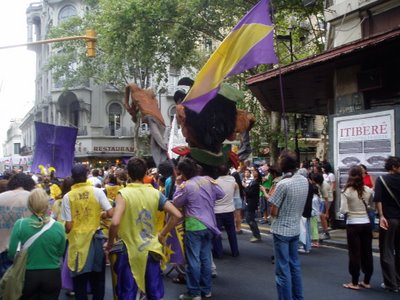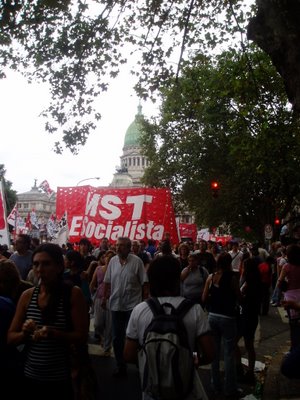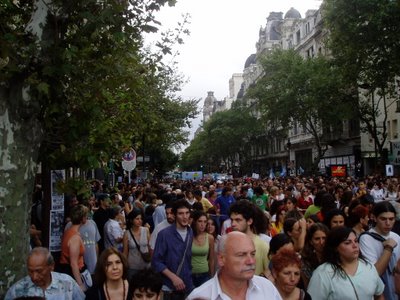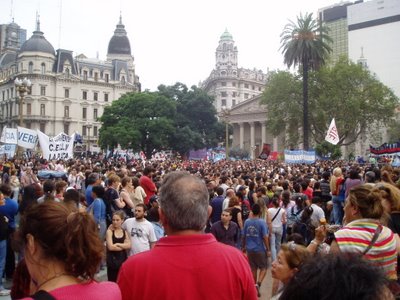Nunca más
Today is March 26, 2006; 30 years and two days after a coup d’état forced Isabel Perón from office, commencing seven years of military dictatorship and a program of state terrorism that would come to be known as la Guerra Sucia (“the Dirty War”). Of course, the remembrance of a terrible past, the marches, the closed shops, the eerie calm about the city lasted only for one day; yesterday was a typically well-attended Saturday, with the exception of those who had chosen to spend their long weekend at one of the numerous Atlantic coast beach resorts. Were it only two days since the coup, and not 30 years and two days, I suspect that the coup would seem less like a one-day event than a discernable, but irrelevant starting point. Such is the weakness of anniversaries: those who survived lived every day of the Dirty War’s seven years, not just the first and last, the latter of which will likely also be commemorated. “Was that really seven years ago?” might be the future’s typical response. Time flies when your children haven’t been disappeared.
Before going too much further, I’ll throw in one of many photos that I took at the march on Friday:

The large puppet is an effigy of General Rafael Videla, leader of the coup and one of three dictators to run the country during the subsequent seven years. It’s not a great photo, and I’ll attach a better one later, but I wanted to draw attention to the woman holding up Videla’s right arm; the one with the Uncle Sam hat. Extra credit if you can piece together the symbolism. A timely release of documents by the National Security Archive on Thursday details Henry Kissinger’s immediate support for the military regime, and cooperation between the Southern Cone’s secret police forces operating under Operation Condor. The day after Kissinger’s staff meeting, though well after the U.S. was aware of the planned coup, the IMF released a $127 million credit for the military junta. Argentine citizens have rarely found themselves on the right end of an IMF loan, but that’s another matter.
Another photo, this one taken at the Congreso, the plaza out front of the Argentine Congress building. The march began at the Congreso and proceeded to the Plaza de Mayo in front of the Casa Rosada, about a kilometre away.

A few examples of the many banners that political groups had created for the event, and these were a representative sample. We’ve got the Socialists on the left; ‘Che’ Guevara – by far the best represented guy there – next on the right; followed by one I can’t make out, though the colour, star, and Che symbol suggest that this is not the extreme right wing; two to the right are the Communists, with a nicely drawn hammer and sickle, and of course the ubiquitous Che. In case anyone doesn’t know much about Che – for instance, if you’ve ever worn a t-shirt with his face on it – Ernesto ‘Che’ Guevara was born in Rosario, now Argentina’s third-largest city, north-west of Buenos Aires. While he did his revolutionary work in Cuba, the Congo, and finally Bolivia, he still had an indirect influence at home, providing an inspiration for leftist guerillas who opposed the military governments of the late 60’s and early 70’s, and even the Perón administrations of 1973-1976. So he’s not just a benign symbol of vague leftist ideologies here: he represents the actual struggles of the extreme left to incite revolution.
While you don’t have to idolize Lenin and Mao to show your distaste for seven years of state repression and terrorism, there is a definite political stripe here that runs down through extreme resistance to the military junta; through socialism and even communism; through opposition to the United States’s occupation of Iraq; through China, Russia, and Cuba; through Che and leftist guerillas. The alliance between these political imperatives was laid bare on Friday: they shared space on banners, in stencils spray-painted on the walls of buildings between the Congreso and Plaza de Mayo, and on the leaflets that activists handed out at every corner. One may support one of these movements and have contempt for another, but regardless, the way between them is well traveled.
This is what surprised me about Friday’s demonstration. I had come expecting a sombre mood, images of the dead, and moments of silence. What I saw instead was a political demonstration. While the junta’s crimes were certainly the day’s cynosure; in each group, in every speech, the actions of the past were examined with an eye to present and future political action. Not everyone feels this way of course – Kirchner’s narrative was something along the lines of “past bad, present good”, and the more incendiary speeches conflicted with the message that traditional groups, such as the Madres de Plaza de Mayo, were trying to get across – but most of the people at the Plaza de Mayo on Friday wanted more than just awareness: they wanted change. Media outlets reported that at least 30,000 people likely came out, and the event was almost entirely peaceful, though one riot broke out near the Plaza San Martin. Two days on, thirty years on, and the wounds are still fresh.

Approaching along Callao.

The kids love Che.

Socialists are in the house; Congreso in the background.

A better view of Señor Videla. Videla is currently under house arrest, awaiting trial.

Just a huge number of people along the Avenida de Mayo.

The Joventud Peronista were one of many young, leftist groups in attendance, but they're distinguished by their history. During Juan Domingo Perón's exile, the JP evolved into a resistance movement; their more militant wing - the Montoneros - embarked on a campaign of robberies and political kidnappings in the late 60's and early 70's. When Perón returned in 1973, his coalition had become so fractured by divergent interests that his arrival literally triggered a battle. On June 20, 1973, as hundreds of thousands awaited his plane at Ezeiza airport, a scuffle between the Montoneros and armed union guards (unions being Perón's traditional power base) evolved into a firefight that left hundreds killed or injured. In the following year before his death, Perón would begin to crack down on his party's extreme left wing, pushing them onto their own branch of revolutionary, Che-inspired politics.

Plaza de Mayo. Just one cross-section of the massive crowd.

The Casa Rosada, behind a large, temporary barrier, guarded. And I was hoping to see a President evacuated by helicopter. Maybe next demonstration.

2 Comments:
My favourite tshirt has a picture of che on it, and then the caption underneath:
"I have no idea who this is."
12:17 p.m.
I'm totally susceptible to flattery, and would love to read and link up "Behind the Boredom", but it comes up all 404. What gives?
2:51 a.m.
Post a Comment
<< Home